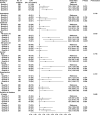Association of Urinary Sodium Excretion and Left Ventricular Hypertrophy in People With Type 2 Diabetes Mellitus: A Cross-Sectional Study
- PMID: 34650519
- PMCID: PMC8505965
- DOI: 10.3389/fendo.2021.728493
Association of Urinary Sodium Excretion and Left Ventricular Hypertrophy in People With Type 2 Diabetes Mellitus: A Cross-Sectional Study
Abstract
Background: It has been well documented that left ventricular hypertrophy (LVH) is highly associated with the incidence of cardiovascular disease (CVD). Evidence indicated that high sodium intake was closely related with LVH in general population. However, information is not available regarding the association between urinary sodium excretion and LVH in patients with type 2 diabetes mellitus (T2DM). This study aimed to explore the association between urinary sodium excretion and LVH in patients with T2DM.
Methods: This cross-sectional analysis included baseline data from 1,556 individuals with T2DM enrolled in the NanFang Prospective Diabetes Study (NFPDS). Urinary sodium excretion levels were measured from 24-hour urine samples of inpatients and morning fasting urine samples of outpatients. Left ventricular dimensions were assessed by echocardiography. The associations between urinary sodium excretion and the risks of cardiovascular events, LVH and left ventricular mass index (LVMI) were examined using linear regression analysis, logistic regression and restricted cubic splines (RCS).
Results: Urinary sodium excretion levels were positively associated with cardiometabolic risk factors, including systolic blood pressure, body mass index, waist circumference and LVMI (All P<0.001). Odds ratios of the highest quartile of urinary sodium excretion compared with the lowest quartile were 1.80 (95% CI, 1.28-2.54; P=0.001) for LVH and 1.77 (95% CI, 1.06-2.94; P=0.028) for CVD, after adjusted for demographics, lifestyle risk factors and cardiovascular risk factors. Multivariable-adjusted RCS analysis of the association between urinary sodium excretion and LVMI showed a significant association (P=0.001) and lacked evidence of a nonlinear association (P=0.406).
Conclusion: This study indicated that high urinary sodium excretion was independently associated with increased risk of LVH and CVD in patients with T2DM, suggesting that control of sodium intake may be valuable for the prevention of diabetic cardiovascular complications.
Keywords: cardiovascular disease; left ventricular hypertrophy; metabolism; type 2 diabetes mellitus; urinary sodium excretion.
Copyright © 2021 Liu, Yang, Zhang, Guo, Xu, Huang, Xue and Zhang.
Conflict of interest statement
The authors declare that the research was conducted in the absence of any commercial or financial relationships that could be construed as a potential conflict of interest.
Figures


Similar articles
-
Diabetic microvascular complications are associated with left ventricular hypertrophy in patients with type 2 diabetes mellitus.J Diabetes Complications. 2025 Feb;39(2):108947. doi: 10.1016/j.jdiacomp.2024.108947. Epub 2024 Dec 29. J Diabetes Complications. 2025. PMID: 39823781
-
Association of Urinary Sodium Excretion and Diabetic Kidney Disease in Patients With Type 2 Diabetes Mellitus: A Cross-Sectional Study.Front Endocrinol (Lausanne). 2021 Oct 28;12:772073. doi: 10.3389/fendo.2021.772073. eCollection 2021. Front Endocrinol (Lausanne). 2021. PMID: 34777262 Free PMC article.
-
The association of perirenal adipose tissue accumulation with left ventricular hypertrophy and the mediating role of insulin resistance: a cross-sectional study involving 1112 individuals with type 2 diabetes mellitus.Front Endocrinol (Lausanne). 2025 Jan 9;15:1465577. doi: 10.3389/fendo.2024.1465577. eCollection 2024. Front Endocrinol (Lausanne). 2025. PMID: 39850485 Free PMC article.
-
Left Ventricular Hypertrophy in Diabetic Cardiomyopathy: A Target for Intervention.Front Cardiovasc Med. 2021 Sep 29;8:746382. doi: 10.3389/fcvm.2021.746382. eCollection 2021. Front Cardiovasc Med. 2021. PMID: 34660744 Free PMC article. Review.
-
24-Hour Urinary Sodium Excretion Association with Cardiovascular Events: A Systematic Review and Dose-Response Meta-Analysis.Biomed Environ Sci. 2022 Oct 20;35(10):921-930. doi: 10.3967/bes2022.119. Biomed Environ Sci. 2022. PMID: 36443269
Cited by
-
Association of triglyceride glucose-body mass index and left ventricular hypertrophy in patients with IgA nephropathy: a retrospective study.Eur J Med Res. 2024 Dec 26;29(1):627. doi: 10.1186/s40001-024-02234-3. Eur J Med Res. 2024. PMID: 39726054 Free PMC article.
-
The Remaining Conundrum of the Role of the Na+/H+ Exchanger Isoform 1 (NHE1) in Cardiac Physiology and Pathology: Can It Be Rectified?Rev Cardiovasc Med. 2022 Aug 15;23(8):284. doi: 10.31083/j.rcm2308284. eCollection 2022 Aug. Rev Cardiovasc Med. 2022. PMID: 39076631 Free PMC article. Review.
References
-
- Federation ID . Diabetes and Cardiovascular Disease. Brussels, Belgium: International Diabetes Federation; (2016). Available at: www.idf.org/our-activities/care-prevention/cardiovascular-disease/cvd-re....
-
- Drazner M, Rame J, Marino E, Gottdiener J, Kitzman D, Gardin J, et al. . Increased Left Ventricular Mass is a Risk Factor for the Development of a Depressed Left Ventricular Ejection Fraction Within Five Years: The Cardiovascular Health Study. J Am Coll Cardiol (2004) 43(12):2207–15. doi: 10.1016/j.jacc.2003.11.064 - DOI - PubMed
Publication types
MeSH terms
Substances
LinkOut - more resources
Full Text Sources
Medical

